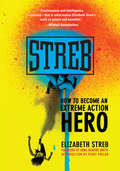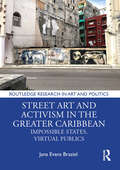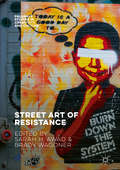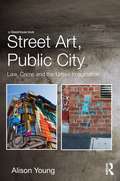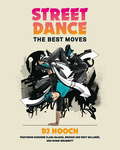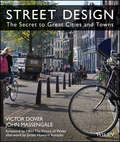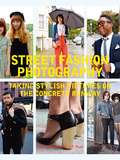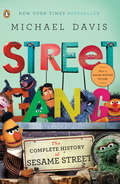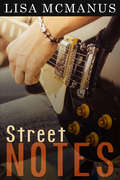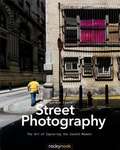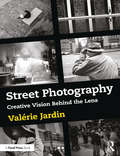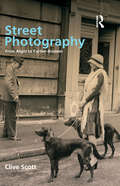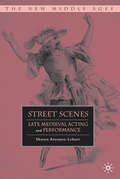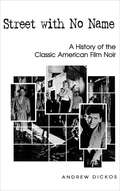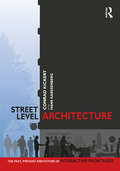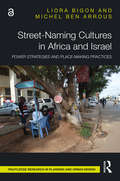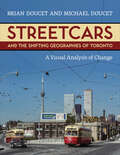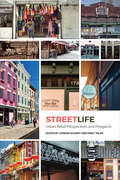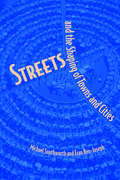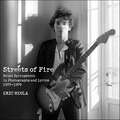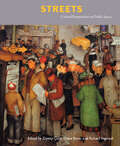- Table View
- List View
Streb: How to Become an Extreme Action Hero
by Elizabeth StrebAn inspiring memoir and self-help guide to greatness by the dancer Mikhail Baryshnikov calls &“fearlessness and intelligence combined . . . potent and beautiful.&” Called &“the Evel Knievel of Dance,&” Elizabeth Streb has been pushing boundaries and testing the potential of the human body since childhood. Can she fly? Can she run up walls? Can she break through glass? How fast can she go? With clarity and humor—and with her internationally-renowned dance troupe STREB—she continues to investigate what movement truly is and has come to these conclusions: It&’s off the ground! It creates impact! And it hurts trying to stop! Here, Streb combines memoir and analysis to convey how she became an extreme action dancer and choreographer, developing a form of movement that&’s more NASCAR than modern dance, more boxing than ballet, and more than most people can handle &“in this dizzying, inspirational self-help&” books (Publishers Weekly, starred review).
Street Art and Activism in the Greater Caribbean: Impossible States, Virtual Publics (Routledge Research in Art and Politics)
by Jana Evans BrazielForegrounding street art in the capital cities of Cuba, Haiti, and Puerto Rico, this book argues that Antillean street artists diagnose the “impossible state” of the arrested present (colonized, occupied, or under dictatorship) while simultaneously imagining liberated futures and fully sovereign states. Jana Evans Braziel launches a comparative study of art, politics, history, urban street cultures, engaged citizenships, and social transformations in three Antillean capital cities—Havana, Cuba; Port-au-Prince, Haiti; and San Juan, Puerto Rico—of the Greater Caribbean. The book includes a photo documentary archive of street art, murals, and installations by key muralists in these cities: Yulier Rodriguez Pérez, "Jerry" Rosembert Moïse, and Colectivo Moriviví (Chachi González Colón, Raysa Rodríguez García, and Salomé Cortés). Braziel offers art historical and geopolitical analyses of the urban street art in their cities of production, underscoring street art as political, economic, and environmental engagements (and not as exclusively aesthetic ones) with urban space and street life. The book will be of interest to scholars working in art history, Caribbean studies, Latin American studies, and urban studies.
Street Art of Resistance (Palgrave Studies in Creativity and Culture)
by Brady Wagoner Sarah H. AwadThis book explores how street art has been used as a tool of resistance to express opposition to political systems and social issues around the world. Aesthetic devices such as murals, tags, posters, street performances and caricatures are discussed in terms of how they are employed to occupy urban spaces and present alternative visions of social reality. Based on empirical research, the authors use the framework of creative psychology to explore the aesthetic dimensions of resistance that can be found in graffiti, art, music, poetry and other creative cultural forms. Chapters include case studies from countries including Brazil, Canada, Chile, Denmark, Egypt, Ireland, Mexico and Spain to shed new light on the social, cultural and political dynamics of street art not only locally, but globally. This innovative collection will be of particular interest to scholars of social and political psychology, urban studies and the wider sociologies and is essential reading for all those interested in the role of art in social change.
Street Art, Public City: Law, Crime and the Urban Imagination
by Alison YoungWhat is street art? Who is the street artist? Why is street art a crime? Since the late 1990s, a distinctive cultural practice has emerged in many cities: street art, involving the placement of uncommissioned artworks in public places. Sometimes regarded as a variant of graffiti, sometimes called a new art movement, its practitioners engage in illicit activities while at the same time the resulting artworks can command high prices at auction and have become collectable aesthetic commodities. Such paradoxical responses show that street art challenges conventional understandings of culture, law, crime and art. Street Art, Public City: Law, Crime and the Urban Imagination engages with those paradoxes in order to understand how street art reveals new modes of citizenship in the contemporary city. It examines the histories of street art and the motivations of street artists, and the experiences both of making street art and looking at street art in public space. It considers the ways in which street art has become an integral part of the identity of cities such as London, New York, Berlin, and Melbourne, at the same time as street art has become increasingly criminalised. It investigates the implications of street art for conceptions of property and authority, and suggests that street art and the urban imagination can point us towards a different kind of city: the public city. Street Art, Public City will be of interest to readers concerned with art, culture, law, cities and urban space, and also to readers in the fields of legal studies, cultural criminology, urban geography, cultural studies and art more generally.
Street Dance: The Best Moves
by DJ HoochSTREET DANCE: THE BEST MOVES is the perfect introduction to major street dance styles with easy-to-follow step-by-step photography. As well as learning the various types of street dance, including B-boy, Popping, Locking, Hip Hop and House - and the basic moves of each of these - you'll get tips on the best tracks to dance to, what clothes to wear to look the part, and be given expert advice from top dancers across the globe. .Throughout the book there are also embedded videos, showing the step-by-steps put into practice so you can check you're doing it right!
Street Design
by John Massengale Victor Dover"The best streets in the world's villages, towns, and cities--whether modest or grand--continually remind one that simplicity is part of the recipe for success in this art. The advice of Victor Dover and John Massengale, their historic examples and their own designs, reflect that simplicity. " --From the Foreword by HRH The Prince of Wales "Street Design is a lucid, practical and altogether indispensable guide for envisioning and creating vibrant 21st century towns and cities. It should be required reading for every local political leader, planner, architect, real estate developer and engaged urban citizen in America. " --Kurt Andersen, host of Studio 360 and author of True Believers "We are going to start walking around the places we live again, and as that occurs and becomes normal, we will rapidly redevelop a demand for higher quality in building at the human scale. " --From the Afterword by James Howard Kunstler "Your charrette traveling library must include the important Street Design book by Victor Dover and John Massengale. "--Bill Lennertz, Executive Director, National Charrette Institute "What an amazing resource! For those who wish that my book, Walkable City, had pictures, this is the book for you. If either your work or your play includes the making of places, you will find Street Design to be an invaluable tool. " --Jeff Speck, AICP, CNU-A, LEED-AP, Hon. ASLA Written by two accomplished architects and urban designers, this user-friendly street design manual shows both how to design new streets and enhance existing ones. It offers step-by-step instruction and shares examples of excellent streets, examining the elements that make them successful as well as how they were designed and created. Topics also include strategies for shaping space in the public right-of-way through correct building height to street width ratios, terminated vistas, landscaping, and street geometry. This book is a valuable resource for urban designers, planners, architects, and engineers. With guest essays from: Kaid Benfield, David Brussat, Javier Cenicacelaya, Hank Dittmar, Andres Duany, Douglas Duany, Emily Glavey, Chip Kaufman, Ethan Kent, Marieanne Khoury-Vogt, Léon Krier, Gianni Longo, Thomas Low, Laura Lyon, Chuck Marohn, Paul Murrain, John Norquist, Stefanos Polyzoides, Gabriele Tagliaventi and Erik Vogt.
Street Fashion Photography
by Dyanna Dawson John TranCity sidewalks are a concrete runway of style innovations just begging to be photographed. For beginning and seasoned shutterbugs alike, this handy manual is the ultimate guide to capturing great looks spotted on the street. In breezy accessible text, the fashion writers behind the popular blog Street Fashion Style reveal insider tips on all the essentials: choosing on-the-go camera equipment, approaching and styling subjects, securing model releases, composing and lighting an incredible shot, creating a street style blog, and so much more. Fully illustrated with tons of super-chic example shots, this book offers plenty of practical advice for budding street fashion photographers, plus endless inspiration for style seekers.
Street Gang
by Michael DavisThe story of one of the most important and beloved shows on television-how it got started, nearly failed, and was saved by Elmo When the first episode aired on November 10, 1969, Sesame Streetrevolutionized the way education was presented to children on television. It has since become the longest-running children's show in history, and today reaches 8 million preschoolers on 350 PBS stations and airs in 120 countries. Street Gangis the compelling and often comical story of the creation and history of this media masterpiece and pop culture landmark, told with the cooperation of one of the show's cofounders, Joan Ganz Cooney. Sesame Streetwas born as the result of a discussion at a dinner party at Cooney's home about the poor quality of children's programming and hit the air as a big bang of creative fusion from Jim Henson and company, quickly rocketing to success. Street Gangtraces the evolution of the show from its inspiration in the civil rights movement through its many ups and downs-from Nixon's trying to cut off its funding to the rise of Elmo-via the remarkable personalities who have contributed to it. Davis reveals how Sesame Streethas taught millions of children not only their letters and numbers, but also cooperation and fair play, tolerance and self-respect, conflict resolution, and the importance of listening. This is the unforgettable story of five decades of social and cultural change and the miraculous creative efforts, passion, and commitment of the writers, producers, directors, animators, and puppeteers who created one of the most influential programs in the history of television.
Street Notes
by Lisa McmanusAll 15-year-old Nick Zinsky wanted was a guitar of his own and a necklace for his mom, and he wanted to buy both on his own, without anyone’s help.Nick’s mom want him to focus on school and not get a job. But Nick is anxious to save up, so he spends the summer and weekends busking downtown with a guitar loaned from school – a secret he has to keep from his mom, his music teacher, his friends, and especially from the school bully, Beau. But when a music competition is announced where the prizes would solve all Nick’s problems, Nick lacks the confidence to enter. Can he find the courage to enter and will it make his problems disappear? Author note: ‘Street Notes’ is a story about bullying, a teens’ struggle for independence, and about learning that sometimes it’s okay to ask for help. This book was previously published with the title “Newbie Nick” in June 2014.
Street Photography
by Gordon LewisSince the advent of the camera, there have been photographers whose mission is to record and interpret the public sphere in all its aspects. Eugene Atget documented evidence of everyday life in the streets as well as the buildings and monuments of Paris. Henri Cartier-Bresson pursued what he called "The Decisive Moment," the moment in which the meaning of an event was most clearly captured in a photograph. Their work, and that of many other masters, has inspired generations of photographers to wander public spaces, camera in hand, searching for meaningful moments in time.Success requires the street photographer to be proficient with their equipment, to be constantly aware of their surroundings, and to have a keen eye. Quick reflexes and self-confidence are essential: Street photographers know from experience that hesitation or procrastination could mean missing a once-in-a-lifetime shot. The adage "it's better to ask for forgiveness than permission" was probably coined by a street photographer. In Street Photography: The Art of Capturing the Candid Moment, Gordon Lewis helps readers understand and conquer the challenging yet rewarding world of street photography. The book includes discussions of why photographers are drawn to street photography, the different styles of street photography, and what makes a great street photograph. Lewis then goes on to explore how the choice of location can change a photographer's approach to image capture: from city streets to fairs to beaches, Lewis discusses the impact different environments have on the process of street photography. Another crucial element to becoming a good street photographer is learning to travel light, with minimal equipment. Lewis gives readers practical advice on everything from cameras and lenses to camera bags and clothing. Lewis also delves into the techniques and approaches that will help novices master the art of street photography. Whether your style is to engage your subjects or to remain unnoticed and take candid portraits, Lewis offers ideas on how to capture fascinating moments in time: a gesture, expression, or composition that may exist for only a fraction of a second, but can leave a lasting impression of the wonders, challenges, and absurdities of modern life.
Street Photography: Creative Vision Behind the Lens
by Valérie JardinWith both training and preparation, a street photographer needs to make rapid decisions; there may only be a fraction of a second to immortalize a moment in time that has never happened before and will never happen again. This is where Street Photography: Creative Vision Behind the Lens comes in. Follow Valérie Jardin on an inspiring photo walk around the world. After an overview of the practical and technical aspects of street photography, Valérie takes you along on a personal photographic journey as she hits the streets of her favorite urban haunts. She shows you the art of storytelling through her photographs, from envisioning the image to actually capturing it in the camera. Learn about the technical and compositional choices she makes and the thought process that spurred the click of the shutter. Perfect for both the new photographer excited to capture the world around them and for the experienced street photographer wishing to improve their techniques and images, Street Photography requires no special equipment, just a passion for seeing and capturing the extraordinary in the ordinary.
Street Photography: From Brassai to Cartier-Bresson
by Clive ScottStreet photography is perhaps the best-loved and most widely known of all photographic genres, with names like Cartier-Bresson, Brassai and Doisneau familiar even to those with a fleeting knowledge of the medium. Yet, what exactly is street photography? From what viewpoint does it present its subjects, and how does this viewpoint differ from that of documentary photography? Looking closely at the work of Atget, Kertesz, Bovis, Rene-Jacques, Brassai, Doisneau, Cartier- Bresson and more, this elegantly written book, extensively illustrated with both well-known and neglected works, unpicks Parisian street photography's affinity with Impressionist art, as well as its complex relationship with parallel literary trends and authors from Baudelaire to Philippe Soupault. Clive Scott traces street photography's origins, asking what really what happened to photography when it first abandoned the studio, and brings to the fore fascinating questions about the way the street photographer captures or frames those subjects - traders, lovers, entertainers - so beloved of the genre.In doing so, Scott reveals street photography to be a poetic, even 'picturesque' form, looking not to the individual but to the type; not to the 'reality' of the street but to its 'romance'.
Street Scene: How To Draw Graffiti-Style
by John LeeCreate your own slammin', street-smart comic art! Contains 28 step-by-step demonstrations in an edgy, high-impact style. Whether you're an aspiring comic-artist or you just wanna have fun drawing ? this book shows you how to rock out in your own gritty, graffiti-influenced style. Start with simple shapes and stick figures and build up to full, fleshed-out dudes and babes with serious attitude! Draw a radical cast of 18 characters step by step, including hip hop artists, rappers, graffiti artists, DJs, skatekids, BMX riders, basketball players, snowboarders, Goth girls, fashionistas, punk rockers, and other urban characters. Express your characters' style with the coolest hairstyles, clothing, shoes, bling, hats, glasses, bags, piercings, tattoos and gear. Let your characters kick it in ultra-cool environments, from gritty cityscapes and zany interiors to wild and abstract backgrounds. From feet to facial expressions, you'll get lots of expert tips for awesome results. It's everything you need to create maximum-impact art that expresses your own sense of style and individuality ? Art that says, "I was here!"
Street Scenes
by Sharon Aronson-LehaviStreet Scenes reconstructs performance theory of religious vernacular theatre in the late medieval period through a fresh and original reading of Tretise of Miraclis Pleyinge.
Street with No Name: A History of the Classic American Film Noir
by Andrew DickosThis history of film noir explores the legacy and aesthetic roots of American filmmakers including Orson Welles, John Huston, Otto Preminger, and others. Flourishing in the United States during the 1940s and 50s, the bleak, violent genre of filmmaking known as film noir reflected the attitudes of writers and auteur directors influenced by the events of the turbulent mid-twentieth century. Films such as Force of Evil, Night and the City, Double Indemnity, Kiss Me Deadly and later on, Chinatown and The Grifters are indelibly American. Yet the sources of this genre were found in Germany and France and imported to Hollywood by emigré filmmakers. Andrew Dickos's Street with No Name traces film noir back to its roots in German Expressionist cinema and the French cinema of the interwar years. Dickos describes the development of film noir in America from 1941 through the 1970s, covering notable directors such as Orson Welles, Fritz Lang, John Huston, Nicholas Ray, Robert Aldrich, Samuel Fuller, Otto Preminger, Robert Siodmak, Abraham Polonsky, Jules Dassin, Anthony Mann and others. Dickos also charts the genre's influence on such celebrated postwar French filmmakers as Jean-Pierre Melville, François Truffaut, and Jean-Luc Godard. Addressing the aesthetic, cultural, political, and social concerns of its creators, Street with No Name demonstrates how film noir generates a highly expressive, raw, and violent mood as it exposes the ambiguities of modern postwar society.A Choice Outstanding Academic Title
Street-Level Architecture: The Past, Present and Future of Interactive Frontages
by Conrad Kickert Hans KarssenbergThis book provides the tools to maintain and rebuild the interaction between architecture and public space. Despite the best intentions of designers and planners, interactive frontages have dwindled over the past century in Europe and North America. This book demonstrates why even our best intentions for interactive frontages are currently unable to turn a swelling tide of economic and technological evolution, land consolidation, introversion, stratification, and contagious decline. It uses these lessons to offer concrete locational, programming, design, and management strategies to maximize street-level interaction and trust between street-level architecture, its inhabitants, and the city. This book demonstrates that designers, developers, planners, and managers ultimately have to create the right preconditions for inhabitants and passersby to bring frontages to life. These preconditions connect architecture to its urban, social, economical, and technological context. Only the right frontage in the right context, with the right design, the right inhabitation, and the right attitude to the city will become part of the ecosystem of trust and interaction that supports public life. This book empowers the many participants in this ecosystem to build, inhabit, and enjoy truly urbane architecture.
Street-Naming Cultures in Africa and Israel: Power Strategies and Place-Making Practices
by Liora Bigon Michel Ben ArrousThis book is focused on the street-naming politics, policies and practices that have been shaping and reshaping the semantic, textual and visual environments of urban Africa and Israel. Its chapters expand on prominent issues, such as the importance of extra-formal processes, naming reception and unofficial toponymies, naming decolonisation, place attachment, place-making and the materiality of street signage. By this, the book directly contributes to the mainstreaming of Africa’s toponymic cultures in recent critical place-names studies. Unconventionally and experimentally, comparative glimpses are made throughout between toponymic experiences of African and Israeli cities, exploring pioneering issues in the overwhelmingly Eurocentric research tradition. The latter tends to be concentrated on Europe and North America, to focus on nationalistic ideologies and regime change and to over-rely on top-down ‘mere’ mapping and street indexing. This volume is also unique in incorporating a rich and stimulating variety of visual evidence from a wide range of African and Israeli cities. The materiality of street signage signifies the profound and powerful connections between structured politics, current mundane practices, historical traditions and subaltern cultures. Street-Naming Cultures in Africa and Israel is an important contribution to urban studies, toponymic research and African studies for scholars and students. Chapters 1 and 2 of this book are freely available as a downloadable Open Access PDF under a Creative Commons Attribution-Non Commercial-No Derivatives 4.0 license available at http://www.taylorfrancis.com/books/e/9781003173762
Street-by-Street Retrofit: A Future for Architecture (Routledge Research in Architecture)
by Mike McEvoyFor many years, it has been recognised that improving the energy performance of the existing housing stock is vital if energy demand is to be reduced to combat climate change. The art of retrofit is posited as a way forward beyond today’s weak pseudo-Modernist architecture – all that is left – the final echo of Modernism’s original utopian impulse.Central to the book is the presentation of domestic street-by-street retrofit as an issue with technical, financial and societal dimensions. A holistic view of the complex, interacting factors that have held back any advance is interspersed with a historical account of retrofit’s faltering progress over the last 20 years. The crucial challenges that have been encountered are described, including the technological and human factors that urgently need to be addressed. It is suggested that the utopian instincts that propelled early Modernism can be redeployed in finding an approach to retrofit that will pave the way towards a politically engaged architecture of social purpose.Street-by-Street Retrofit’s goal is to involve the creative imagination of designers and form an alliance with policymakers and many others in the business of urban improvement; it is intended for all these audiences.
Streetcars and the Shifting Geographies of Toronto: A Visual Analysis of Change
by Brian Doucet Michael DoucetWhen looking at old pictures of Toronto, it is clear that the city’s urban, economic, and social geography has changed dramatically over the generations. Historic photos of Toronto’s streetcar network offer a unique opportunity to examine how the city has been transformed from a provincial, industrial city into one of North America’s largest and most diverse regions. Streetcars and the Shifting Geographies of Toronto studies the city’s urban transformations through an analysis of photographs taken by streetcar enthusiasts, beginning in the 1960s. These photographers did not intend to record the urban form, function, or social geographies of Toronto; they were "accidental archivists" whose main goal was to photograph the streetcars themselves. But today, their images render visible the ordinary, day-to-day life in the city in a way that no others did. These historic photographs show a Toronto before gentrification, globalization, and deindustrialization. Each image has been re-photographed to provide fresh insights into a city that is in a constant state of flux. With gorgeous illustrations, this unique book offers an understanding of how Toronto has changed, and the reasons behind these urban shifts. The visual exploration of historic and contemporary images from different parts of the city helps to explain how the major forces shaping the city affect its form, functions, neighbourhoods, and public spaces.
Streetlife: Urban Retail Dynamics and Prospects
by Emily Talen Conrad KickertOur street-level economy is undergoing dramatic change. Retailers are reeling from the rise of e-commerce, rising rents, and increasing storefront vacancies, along with a cultural shift from material to experiential consumerism. Today, the COVID-19 pandemic is contributing to economic upheaval as commercial corridors and the small businesses they house face sweeping closures, bankruptcy, and job losses. Streetlife brings together scholars who have been trying to make sense of the changing retail landscape at street level and what it means for urbanism’s future. Streetlife pays special attention to the varied responses and policies that have emerged to address the competing realities of small business loss and neighbourhood needs. With case studies from the United States, as well as contributions covering Canada and Europe, this book demystifies the logic behind street-level urban retail and calls for better plans, designs, policies, and innovations to bolster sales. Streetlife shows that now, more than ever before, we need to understand what makes our storefronts tick, what awaits them, and what we can do as planners, designers, developers, entrepreneurs, and policymakers to maintain retail as integral to urban lifestyle.
Streets Reconsidered: Inclusive Design for the Public Realm
by Daniel Iacofano Mukul MalhotraStreets Reconsidered is a fundamental rethinking of America's streets. It explores the future of streets and what America's roadways could be if they were designed for living, instead of just driving. The book includes: detailed design guidelines, fully illustrated, four color case studies of successful streets from around the world, a new paradigm of streets designed to promote human functions, turning new design ideas into a series of best practices that can be applied to any community. What would streets look like if they accommodated people of all ages and abilities, promoted healthy urban living, social interaction and business, the movement of people and goods and regeneration of the environment? Streets Reconsidered pushes beyond the current standards, focusing on the planning, design and construction of streets as a method for improving our built environment for everyone. The book is organized by the functions of a street: mobility, way finding, commerce, social gathering, events and programming, play and recreation, urban agriculture, green infrastructure and image and identity. Streets Reconsidered is the essential resource for city planners, urban designers, developers, architects, landscape architects, policymakers and community members who share a passion for great urban, human spaces.
Streets and Patterns: The Structure Of Urban Geometry
by Stephen MarshallThere is an emerging consensus that urban street layouts should be planned with greater attention to ‘placemaking’ and urban design quality, while maintaining the conventional transport functions of accessibility and connectivity. However, it is not always clear how this might be achieved: we still tend to have different sets of guidance for main road networks and for local streetgrids. What is needed is a framework that addresses both of these, plus main streets – that don’t easily fit either set of guidance – in an integrative manner. Streets and Patterns takes up this challenge to create a coherent rationale to underpin today’s streets-oriented urban design agenda. Informed by recent research, the book looks behind existing design conventions and beyond immediate policy rhetoric, and analyses a range of first principles – from Le Corbusier and Colin Buchanan to New Urbanism. The book provides a new framework for the design and planning of urban layouts, integrating transport issues such as road hierarchy, arterial streets and multi-modal networks with urban design and planning issues such as street type, grid type, mixed-use blocks and urban design coding.
Streets and the Shaping of Towns and Cities
by Michael Southworth Eran Ben-JosephThe topic of streets and street design is of compelling interest today as public officials, developers, and community activists seek to reshape urban patterns to achieve more sustainable forms of growth and development. Streets and the Shaping of Towns and Cities traces ideas about street design and layout back to the early industrial era in London suburbs and then on through their institutionalization in housing and transportation planning in the United States. It critiques the situation we are in and suggests some ways out that are less rigidly controlled, more flexible, and responsive to local conditions. Originally published in 1997, this edition includes a new introduction that addresses topics of current interest including revised standards from the Institute of Transportation Engineers; changes in city plans and development standards following New Urbanist, Smart Growth, and sustainability principles; traffic calming; and ecologically oriented street design. "
Streets of Fire: Bruce Springsteen in Photographs and Lyrics 1977–1979
by Bruce Springsteen Eric Meola“On a day like this, I remember—I’m the President, but he’s The Boss.” —President Barack Obama, 2009 Kennedy Center Awards ceremonyCompiled by accomplished photographer Eric Meola—who knew “the Boss” when he was just an unknown Jersey kid with big rock and roll dreams—Streets of Fire is an intimate photographic look at Bruce Springsteen during a pivotal year in his life and career. In 1977, Springsteen was coming off the enormous success of his album, Born to Run, and in the studio working on his fourth record, Darkness on the Edge of Town—and these breathtaking candid photos are portraits of a master musician finally coming into his own. A stunning collection of photographs—some never before published—of Bruce and the E-Street Band combined with the haunting lyrics of some of Springsteen’s most unforgettable songs, Streets of Fire offers fans a privileged and rarefied look at one of rock’s most legendary and beloved icons.
Streets: Critical Perspectives on Public Space
by Diane Favro Richard Ingersoll Zeynep ÇelikThis collection of twenty-one essays, written by colleagues and former students of the architectural historian Spiro Kostof (1936-1991), presents case studies on Kostof's model of urban forms and fabrics. The essays are remarkably diverse: the range includes pre-Columbian Inca settlements, fourteenth-century Cairo, nineteenth-century New Orleans, and twentieth-century Tokyo. Focusing on individual streets around the world and from different historical periods, the collection is an inviting overview of the street as an urban institution.The theme of the volume is that the street presents itself as the basic structuring device of a city's form and also as the locus of its civilization. Each essay is a detailed investigation of a single urban street with unique historical conditions. The authors' shared concern regarding anthropological, political, and technical aspects of street making coalesce into a critical discourse on urban space. A fitting tribute to Spiro Kostof, this collection will be greatly admired by scholars and general readers alike.
